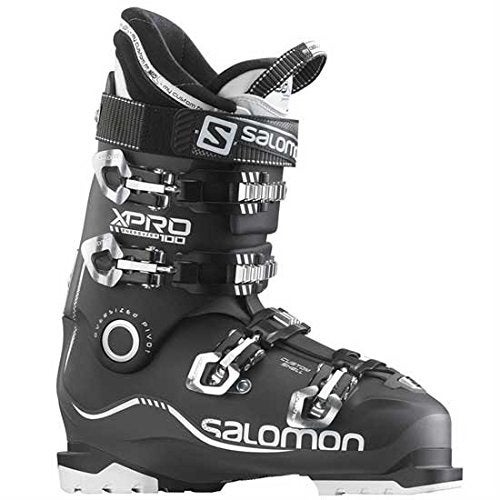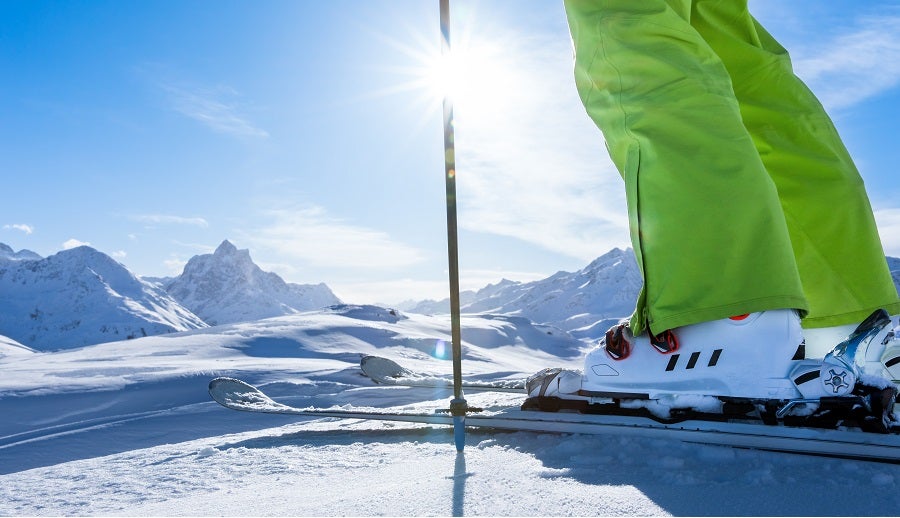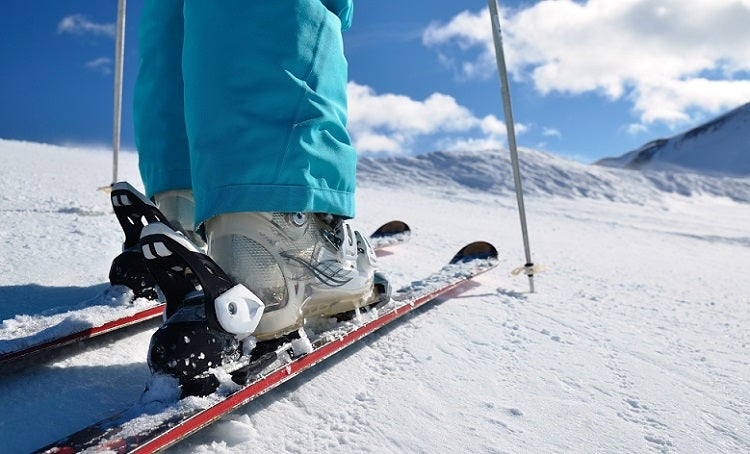
Our Editors independently research, test, and rate what we feel are the best products. We use affiliate links and may receive a small commission on purchases.
You’re thinking about joining some friends on a ski trip, or maybe you’ve decided to learn on your own. Either way, this year is the year you learn to ski!
As a beginner skier, there is already tons of advice, information, and skills to know. It doesn’t help that all the gear is expensive and everyone seems to be trying to sell you something.
As a full time ski instructor at Deer Valley Resort in Utah, I spend over 100 days each winter on skis, teaching guests of all ability levels to ski.
Part of my job is to help new skiers learn not only skills, but understand their equipment. Knowing your equipment, choosing the right equipment, and using it properly can really make or break a new skier’s experience.
Best Beginner Ski Boots
For more of my ski gear recommendations, have a look through these popular Outside Pursuits guide links: Beginner Skis, Ski Jackets, Ski Pants
Quick Answer: The 5 Best Rated Beginner Ski Boots For 2021
- Salomon X Pro 100 Men’s Ski Boots
- Rossignol Kelia 50 Women’s All Mountain Ski Boots
- Dalbello Aspect 100 Men’s Ski Boot
- Salomon X-Access 70 Wide Ski Boots
- HEAD Advant Edge 75 Ski Boot Womens
If you’re going to need a boot bag to carry those ski boots, check out my reviews here. Right now, I’m going to teach you what you need to know to choose your new top rated beginner ski boots!
Beginner Ski Boot Reviews
#1 Salomon X Pro 100 Men’s Ski Boots
- Flex Rating 100
- Heat Moldable
- Last Width 100mm
- Micro Adjust Buckles
Having skied in the Salomon X Max 100 for several years as a full-time instructor, I can tell you that this boot will keep up with you. With a fully heat mold-able shell and liner, this boot is forgiving and starts with a generous 100mm last.
If you’ve got a particularly narrow or low volume foot, go with the X Max which is essentially the same boot with a 98mm last for more narrow feet.
Salomon has done a fabulous job of putting high quality liners in these boots which are comfortable yet snug. Holding down the heel and capturing the entire foot, you can wear these boots comfortable buckled with no pinching.
If your foot is wider or bonier, you’ll want to have them heat molded to fit your foot when you buy them.
Ladies, you’ll enjoy the Salomon X Pro 70 which is made the same boot with a lighter flex. For a beginner female skier, it should be more than enough and you can always move up in flex rating as you progress.
These boots are made to the same standard as my old favorites, the X Max 100’s. Overall, the Salomon X Pros are the best ski boots for beginners.
#2 Rossignol Kelia Women’s All Mountain Ski Boots
- Flex Rating 50
- Last Width 100mm
- Neutral Stance
- All day warmth
With a flex of 50 and a 104mm last, these boots are very soft and very wide. There’s enough room in here for just about anyone’s foot and that actually might be a bad thing.
If your feet are narrow or small, this boot may be too roomy for you and you’ll end up with a poor boot fit. Poorly fitting boots mean bad technique and difficulty in learning.
However, at a beginner’s price range and with forgiving sizing and specifications, this boot makes a good case for the beginner.
As long as the boot fits properly there’s a lot of good to be said for this entry level beginner women’s ski boot. A soft flex rating is ideal for short or lighter skiers.
Guys, you’re going to have to take a look at the Rossignol Evo 70 which is one of the softest flex ratings you’ll find in a men’s boot and it comes with a similarly generous 104mm last.
#3 Dalbello Aspect 100 Men’s Ski Boot
- Flex Rating 100
- Last Width 102mm
- Neutral Stance
- All day warmth
If you’re looking for something squarely between the sizing of the Rossignol Evo and Kelia model and the Salomon X Pro models, then the Dalbello Aspect might be a good choice.
While each manufacturer measures and sizes boots slightly differently, the Dalbello measures up at a 102mm last. While still quite generous, this might be a good sizing choice for many beginner male skiers with medium sized feet.
This boot does feature a walk/ski mode which some find useful for comfort but it’s definitely not a touring boot. Think twice before deciding on a ski boot with walk / ski mode as this always compromises the overall performance of the boot.
Best for beginners who want the warmest ski boots for those cold days on the slopes!
Ladies, the Dalbello Aspire 60 Ski Boot is the equivalent women’s boot.
#4 Salomon X-Access 70 Wide Ski Boots
- Flex Rating 70
- Last Width 102mm
- Beginner – Intermediate skiers
- Great for those with wide feet
Salomon gets another place on our list for these low flex wide boots that make a perfect choice for beginners or those with wide feet. For some, however, the flex and generous last size will feel sloppy.
Due to the fact that this boot is just an 70 flex boot for men it’s really most appropriate for total beginners. As you progress you’ll need a stiffer boot for finer ski control.
That said, if you’re having trouble finding a comfortable boot or just can’t enjoy learning in the rental boots try these out. They’re less than $200 and Salomon makes a great ski boot. They’re an ideal pick for those with wide feet that feel painful and cramped in other boots.
Just remember that at some point having a boot that’s too wide or too soft in flex can eventually hold you back from unlocking the true potential of controlling your skis.
Best for beginners with wide feet who want the most comfortable ski boots on the mountain.
#5 HEAD Advant Edge 75 Women’s Ski Boot
- Flex Rating 75
- Last Width 102mm
- Relatively upright stance
- Progressive flex
Salomon is almost always my top pick for beginner to intermediate ski boots but HEAD is always my top pick for advanced and expert. In this case, however, they’ve taken their world class expert technology and packed it into a beginner women’s boot.
If you don’t remember, last is the measurement that refers to how wide the ski boots are. At 102 it’s about as wide as it gets so you’ll have a very roomy boot. Plus, HEAD specifically designed this boot with a more upright stance than many of their more performance oriented race boots.
That said, a wide boot with an upright stance, and relatively soft flex might not take you all the way to the pro circuits. It’s definitely a boot with beginner comfort in mind and I think that’s okay because you’re more likely to come back and practice if you leave the hill in comfort, right?
For women, a 75 flex is a decent moderate starting point for most. This won’t be so soft that you have to upgrade right away but it won’t be so stiff that you’re uncomfortable either.
Best for beginners who want a boot that’s easy to spend all day in.
Author’s Expertise / Why You Should Trust Our Reviews
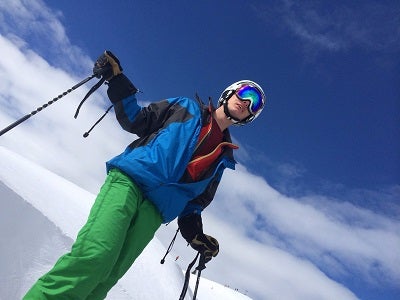
I started writing online for my own outdoor sports blog in 2010. Right out of the gate I landed opportunities to test gear for Road ID, Hydrapak, Wolverine, Helle Knives, Pearl Izumi, and GU Energy. Those were the days when growing a no-name blog was easy. Today niche blogging is a different story.
In 2012 I left Central Wyoming College with a degree in Outdoor Education and Leadership. Soon after, I was on a month-long expedition with the National Outdoor Leadership School’s Outdoor Educator Course which helps would-be outdoor guides ascend from “aspiring” to “inspiring”.
Between here and there I’ve participated in and spoken at length about outdoor pro-deal programs for companies like Patagonia, Smith Optics, Giro, Therm-a-Rest, Platypus, MSR, Columbia, and many more. I still work closely with tons of outdoor gear companies to review and analyze products. If you have a product opportunity you’d like to discuss, please review my guidelines and contact me here.
After several seasons of guiding backpacking trips and working as a certified Alpine Ski Instructor at Deer Valley Resort in Park City, UT for several seasons, I had to move on. As any educator will tell you – teaching doesn’t pay the bills very well.
In 2016 I began building my freelance writing career as readers and other bloggers reached out to me for help with technical outdoor sports content strategy for online businesses. Within weeks I was overloaded with requests for freelance writing and my new career blossomed.
2018 saw the launch of Hike With Less, my ultralight backpacking partnership program with Dustin Walker.
How to Choose the Best Beginner Ski Boots
- Flex Rating
- Sizing
- Last
- Touring vs Alpine vs Tele Boots
- Mistakes To Avoid
- FAQ For Ski Boots
- Conclusion
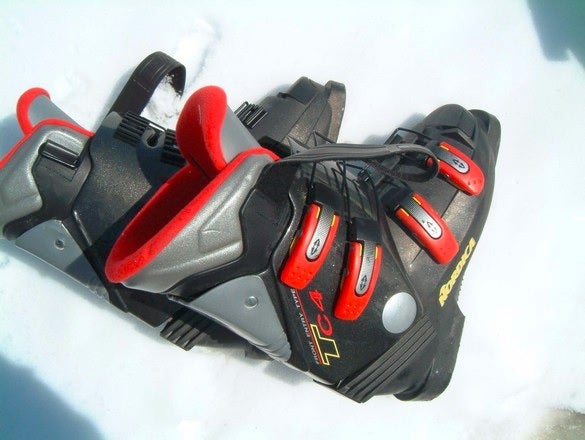
There are a few critical factors that will impact your boot buying decisions. As a beginner, there’s less need to get the *perfect* fit but a poorly fitted boot or an uncomfortable one can really slow learning progress and kill your fun on the hill.
Let’s walk through the most important factors in choosing a beginner ski boot.
Flex Rating
Flex rating is really just a measure of how stiff your new ski boot will be. Flex ratings go as low as 40 and as high as 130 (sometimes higher). To put that into perspective, a 70 flex might be for a lightweight skier or a beginner skier.
Flex of 130 would be for a very tall, heavy, or advanced skier or racer. Generally speaking, lower flex ratings are more ideal for beginner skiers. However, flex rating can also be impacted by height and weight. If you’re taller or heavier, then you’ll want to go up a rating.
If your really not sure, have yourself fitted for boots then go buy them online to save money.
Sizing
Seemingly simple, sizing is measured in “Mondo Point” numbers. These numbers can be easily converted from shoe sizes, however they’re rarely accurate.
Each manufacturer makes boots slightly differently and this means my foot, which fits a Salomon boot very well, may be totally different from yours. This is yet another reason to go and get fitted for boots by a professional, then go buy them online.
Last
This is a vocabulary word which is used to measure the width of a ski boot. Last is measured in millimeters and denotes the width of the foot bed of the boot. A last of 98 or less is usually considered narrow or high performance. Last measurements of 100 or more tend to be a more casual and comfortable fitment.
Touring vs Alpine vs Tele Boots
There are several styles of ski boots and, if you get it wrong, you’ll have a really hard time enjoying your ski day.
Alpine Boots
These are ski boots meant for skiing at the resort. These boots are the appropriate choice for almost every beginner. Featuring a solid shell construction and fixed boot angles, these boots are the most common boot at a resort for a good reason.
Touring Boots
Touring boots are usually lighter, softer (flex wise), and feature some form of “walk mode”. These are for skinning up mountain while backcountry skiing and if you don’t understand what that means, then you’d best avoid a touring boot.
These boots are sometimes called AT boots or randonee boots. Because the walk mode on touring boots makes them more comfortable for skiing, but less effective for learning good technique on groomed runs, they’re best avoided unless you plan to do some backcountry skiing.
Telemark Boots
Sometimes lovingly called drop knee skiing, tele skiing is a form of ski touring or backcountry skiing. Rare in a resort setting but not unheard of, this type of skiing requires special technique, and unique gear.
Telemark boots are different from other boots as they feature a flexible toe piece which looks like an accordion. This articulated joint of the boot is made to accommodate telemark skiing and the boots themselves won’t even fit into regular ski bindings.
Avoid them unless you plan to learn Tele skiing exclusively.
Mistakes To Avoid
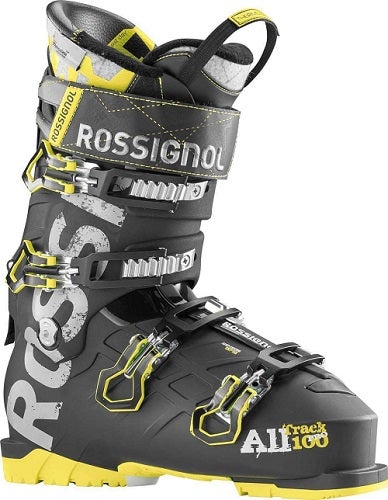
Using Shoe Measurements
Avoid converting your shoe size into ski boot size and buying based on that measurement. It won’t fit well and can lead to many issues. Go and get your boots fitted by a pro.
Buying Used
Most often, used ski boots have seen a lot of use. While the boot may still be in usable condition, the liner (inside) is usually packed out, stinky, and generally useless.
Only buy used ski boots if you already know your size and fitment and plan to replace the liner with an aftermarket replacement.
Staying Too Comfortable
Ski boots are meant to fit snugly but they shouldn’t be rubbing, pinching, or painful. The best way to describe a good fit is to imagine the ski boot “hugging” your entire foot snugly.
There should be no room to lift up your heel, the foot should not “slop” from side to side. A little wiggle room in the toes is ideal to keep blood flowing but almost everything else should be locked down.
FAQs For Beginner Ski Boots
Q: Should my toes touch the front of the boot?
A: Nope.
To make sure your ski boot is fitted follow these steps:
- Put the boot on
- Slam your heel to the back by tapping the heel of the boot against the floor
- Push the tongue of the boot down
- Tighten all boot straps
- Stand up in an athletic stance and pressure the front of the boot
- Make sure your toes are not touching or sliding into the front of the boot
- Your heel should also not lift out of the heel pocket of the boot
That’s all there is to it!
Okay, I lied there are some finer details but that’s a rough idea of how to get the sizing process started anyways.
Q: What flex boot should I wear?
A: It depends on your skill level, height, and weight. The better you are, the taller you are, and the heavier you are the stiffer boot you’ll need. Those three factors all contribute to flex choice.
For me, at 5’ 10” and 150 lbs I started in a 90 flex boot and that was great for learning. By the time I made it to advance and expert level skiing I moved into the 120 – 130 flex range for most applications (though I still prefer low flex for comfort when teaching beginners).
Flex and boot fitting go hand in hand to create a comfortable experience. Most beginners can get away with a heat molded liner. Men will probably start from 90-100 flex and women will likely start from 60-90 flex.
Q: Are race boots the best kind of boot?
A: No. They’re really not.
Most skiers stay within the casual range and enjoying skiing is important to learning. If you ski a race boot to go “fast” or have high performance you’ll be disappointed. They have very narrow lasts (width) and they’re exceptionally stiff.
Beginners will struggle to master or enjoy a race boot.
Instead go with a nice moderate to low flex boot that you can wear for hours at a time without getting blisters. Making sure your boot is properly fitted is key.
Q: My boots are too tight around _____ area, what do I do?
A: It’s common to buy a pair of boots that just don’t quite fit perfectly. In fact, finding a perfect pair of boots out of the box is almost impossible.
So, what’s to be done?
The most common areas for problems are the knuckle of the big toe and the ankles. These are areas of any ski boot the almost always have to be worked on for skiers to have a perfect fit.
Many pro shops where you buy your boots will do some work on the boots for free when you buy them. Ask if they can “punch out” an area that’s particularly tight. If you buy your boots online though expect to pay for this service.
Liners and shells both can be modified by a good boot tech to fit you just right. They’ll probably recommend that you wear the boots for a few weeks to let them break in before you get any major changes done.
Q: Are ski boots supposed to be uncomfortable?
A: No, not really.
You might hear this from some skiers that, “Your boots should be a little uncomfortable.” To some extent that holds water but it’s really not a good measure of a boot.
At higher flexes like 120-140 boots are so stiff they just don’t move. If you haven’t built up calluses and tolerance to your boots or if they’re not properly fitted for you, they can be anywhere from mildly uncomfortable to straight up rubbing your feet raw.
For beginners to intermediate skiers there’s really no reason to have a painful or uncomfortable boot experience. If you’re getting blisters, chafing, or painful areas go talk to the boot fitters or the rental shop and see if they can help you.
When you first start, expect your feet to take some time to adjust to the feeling of ski boots. Don’t tolerate outright pain, however.
Conclusion
Ultimately ski boots must fit comfortably, transfer power and movement to your skis, and create a stable platform on which to ski.
All day comfort is important so if you’re having rubbing, pinching, hot spots, or irritation then take your boots in to a ski shop and ask them to help you customize the fit. Ski boots can be modified by professionals in order to more properly fit your foot!
There are tons of ski boot options available and I highly recommend that you get fitted for your boots by a professional.
Sloppy ski boots will compromise and hold back your skiing potential. There’s no way to control your skis if your boots are sloppin’ around on your feet!
Stay safe out there and I’ll see you on the mountain!
I hope this guide was helpful for finding the best beginner ski boots to fit your needs. If you want to comment or recommend a pair of boots I didn’t include, please use my contact form to get in touch.
New to skiing? See my beginners guide to skiing for tips and advice.
Have fun and be safe out there!
How We Researched
To come up with the best beginner ski boots, we researched a variety of sources for reviews such as REI, Backcountry, Moosejaw, EVO along with our own personal experience.
We also consulted online magazines for product research and reviews to get as much unbiased information as we could. To help weed out fake reviews we used Fakespot.com to make sure we only looked at genuine reviews.
With so much quality gear available, we had to narrow it down based on what we felt were the best options were for the price. The author, Casey Fiedler was a full-time ski instructor for Park City and The Canyons in Utah.
To help narrow down the selection he used his personal experience along with recommendations from fellow ski instructors.
After extensive research, we came up with our list to help you choose the right one for you.
Sources

